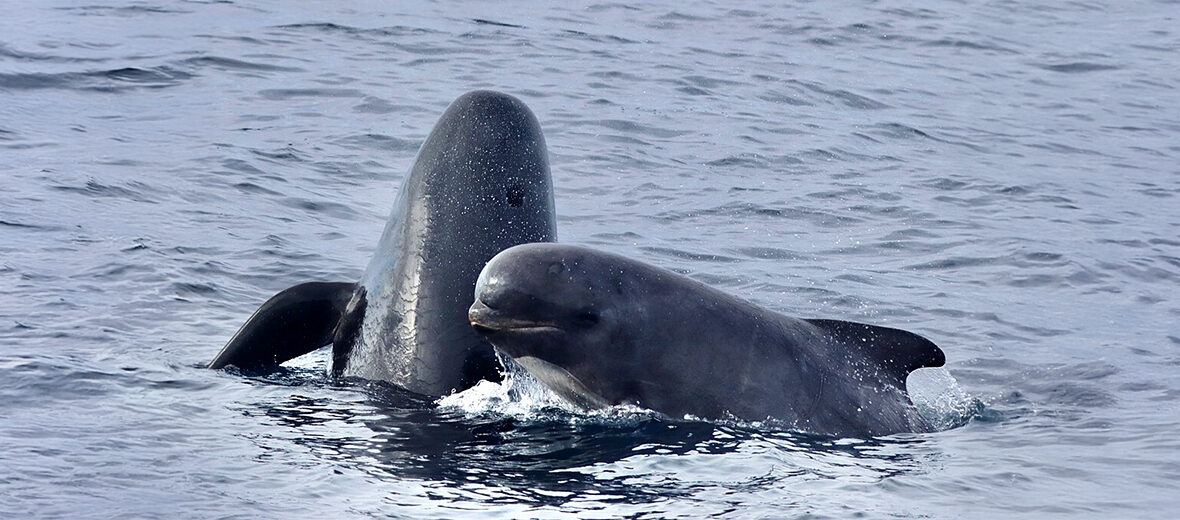
The long-finned pilot whale, aka pothead whale, is actually a large species of dolphin so named for their unusually long pectoral fins. They are found in the North Atlantic as well as the Southern Hemisphere. These dolphins face the threats of overfishing and over harvesting for food and other products; pollution; and climate change, that causes warmer ocean water which affects their food source. While there are no formal numbers listed, and often times their numbers are combined with short-finned pilot whales, These pilot whales are presumed to number in excess of 780,000 worldwide. Thus, they are listed as Least Concern by the IUCN.
First the Stats…
Scientific name: Globicephala melas
Weight: Up to 9,900 lbs.
Length: Up to 25 feet
Lifespan: Up to 60 years
Now on to the Facts!
1.) Pilot whales get their name from the initial belief that there was a “pilot” or lead individual in their pods.
2.) The name for the genus, “Globicephala” hails from a combination of Latin globus meaning “globe” and also Greek kephale meaning “head”. The specific name “melas” is Greek and translates to “black”.
3.) They get the name pothead whale not due to a THC addiction, but rather the resemblance of their head to a black cooking pot.
4.) These dolphins were first described by Thomas Stewart Traill in 1809 and given the name “Delphinus melas”. However, this scientific name was later changed to “Globicephala melaena”. Fast forward to 1986, when the specific name for this species was reverted to its original form as “melas”.
5.) Their pectoral fins can be as long as 27% of their total body length.
But wait, there’s more on the long-finned pilot whale!
6.) These critters have more neocortical neurons (neurons located in the neocortex responsible for higher-level cognitive functions like perception, language, and decision-making) than any mammal studied to date, in fact they have almost 2x as many as humans.
7.) While 20 – 150 individuals are commonly seen, pods of over 1,000 have been documented.
Did you know…?
Long-finned pilot whales are the 2nd largest member of the dolphin family. The 1st place winner is the orca.
8.) Smaller long-term social units made up of around 8 – 12 individuals are often formed.
9.) Calves, females, and perhaps males as well stay with their mothers for life.
10.) Pothead whales have been seen socializing with common bottlenose dolphins, Atlantic white-sided dolphins, and Risso’s dolphins.
But wait, there’s still more on the long-finned pilot whale!
11.) Squid, octopus, crustaceans, and certain fish are all feasted upon.
12.) Breaching (breaking the surface of the water), lobtailing (forcefully slapping their flukes “tail fins” onto the surface of the water), and spyhopping (briefly rising vertically out of the water, holding their head and eyes above the surface, to get a better view of their surroundings) are all common behaviors.
Did you know…?
These dolphins have been observed babysitting calves that are not their own, with 1 study proving that many of those doing the babysitting are males.
13.) During December – March, these dolphins beach themselves in great numbers along the coast of New Zealand. The reasons for these strandings are not fully understood, but due to pilot whales having strong social bonds, it is hypothesized that when 1 strands itself, the rest of the group may have a tendency to follow suit.
14.) The largest stranding event consisted of approximately 1,000 pilots on the Chatham Islands in 1918. Though mass strandings of this species typically takes place in New Zealand, pilot whales have beached themselves in many other countries in places such as northern Europe, the Atlantic coast of North America, South America, and southern parts of Africa.
15.) During their deeper group dives, females on the right and left flanks are found to lead more often than males and juveniles. This may function in a similar fashion to what is observed in cattle drives, where flanking riders are important for maintaining cohesion of the herd of cattle.
But wait, there’s still a bit more on the long-finned pilot whale!
16.) Even though mating can occur at any time of the year, it tends to peak in spring and late summer.
17.) Females undergo up to a 16 month gestation (pregnancy) that yields a single calf.
Did you know…?
These and other pilot whales have been documented chasing, harassing, and/or mobbing other species of cetaceans.
18.) Calves measure up to 6.7 feet and weigh in at about 165 lbs. at birth.
19.) Among a host of other parasites, long-finned pilot whales can be afflicted with Crassicauda carbonelli, a species of nematode which is found exclusively in the male’s penis.
20.) Recently, an adult female Icelandic orca was seen with a newborn pilot whale traveling alongside her in a mother-calf position, leading to the belief that the relationship between both species might be much more complex than previously thought.
But wait, there’s still a tad more on the long-finned pilot whale!
21.) This same orca was seen 1 year later interacting with a larger pod of pilot whales. Whether the newborn calf was adopted or abducted is unclear.
22.) In addition to buzzes, squeaks, whistles, and other calls typically used for communicative purposes, they also produce rapid clicks that function as a familiar type of bio sonar known as echolocation.
Did you know…?
The well articulated skeleton of a long-finned pilot whale, killed in the Firth of Forth in 1867, was put on display at the Leeds City Museum, UK in 2019.
23.) The Baltic Sea and North Sea populations of these dolphins are listed on Appendix II of the Convention on the Conservation of Migratory Species of Wild Animals (CMS), since they have a less than favorable conservation status and could benefit significantly from international co-operation organized by tailored agreements.
24.) Whaling of these dolphins in the Faroe Islands in the North Atlantic has been practiced since the time of the first Norse settlements in that region. The hunts, called grindadráp in Faroese, are primarily executed during the summer.
25.) These critters are economically important in the whale-watching industry in some areas of the world, especially in eastern Canada. Even though there are a variety of other species of whales found in the Gulf of the St. Lawrence and around Newfoundland.
Now a Short Long-Finned Pilot Whale Video!
Be sure to share & comment below! Also, check out the Critter Science YouTube channel. Videos added regularly!
Want to suggest a critter for me to write about? Let me know here.
Some source material acquired from: Wikipedia & IUCN
Photo credit: Vsevolod




